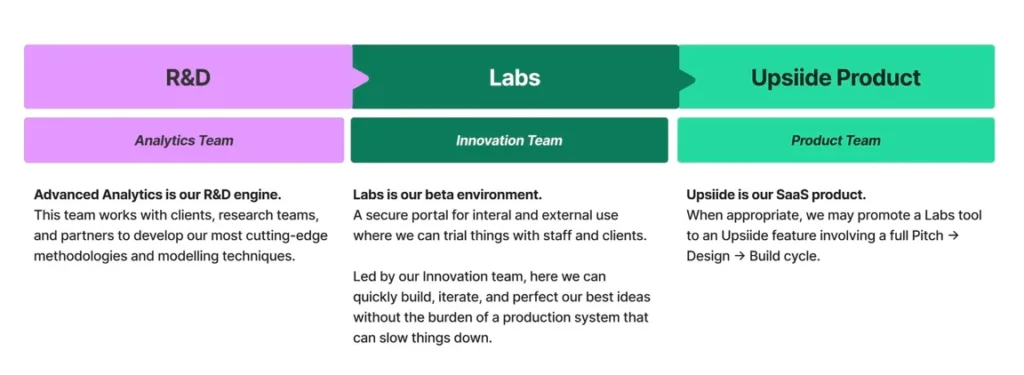Just because you automate your advanced analytics capabilities doesn’t mean you’ll be able to democratize them. But automation is the start of getting democratization done. There is an art to the science of automating market research tools so anyone can use them. Refinement, testing, and repeatability are all needed before our analytics team feels comfortable building a platform for our consultants or clients to use.
How We Approach Automating Analytics
Dig Insights started focusing on automating repetitive tasks because our analytics team recognized they were answering similar questions regularly. It started out as making a simple script to free up time on the team’s end, and automation efforts have progressed from there. The first automated tool we built was in 2014. The year after that, we developed the first iteration of our TURF tool. And now, it’s evolved into building full tools for consultants or clients to use on their own, consisting of a correspondence tool, factor analysis, and network and MDS maps (a.k.a. multidimensional scaling), just to name a few.
At one end of the spectrum lies zero automation and zero democratization – one-off or highly customized requests. At the other end is a fully democratized, self-service platform that handles creation, fieldwork, and automated analysis of the results. (In our case, that’s Upsiide.)

To make our way from 0 to 100, from no automation and democratization to full automation and democratization, we recognize when we get similar requests and start having to do something over and over.
Once we’ve got a good use case in mind, we put together a template within the analytics team that can ingest, transform, record, and fully analyze the data. From there, we build a script to simplify this process. But this is only semi-automated as it still requires some input – creating automated systems that always output correct data can be tricky. This is nowhere near being democratized.
After working out the kinks and ensuring we’re happy with the results (i.e., we don’t have to play around with the parameters for each test), we’ll make the script a fully automated tool. This now becomes a democratized tool for advanced analytics that our consultants can use.
From there, we’ll work towards transforming the tool into something anyone can use. Once it’s up to par, we work to integrate it into our Upsiide platform.
Respecting this process matters because if we can solve these problems once, we subsequently solve them for every study. Every study now reaps the benefits of this kind of standardized approach while still being customizable enough to handle any client need. Additionally, we can continue to work on improvements. For example, maybe we add another layer to a visualization tool to make it more interpretable.
But freeing up time isn’t the only area where you benefit from automation.
Why Automating Advanced Analytics Has Led to Democratization
For us, the true strength of automation has been the time it’s opened to focus on improvements. Instead of handling repeated requests, the analytics team can focus on improving visualizations and testing and refining new methodologies. This allows clients and our Dig consultants to better understand the data gathered and helps them set up their story or strategy.
The benefit of this approach has also been democratizing access to the analytics tools. With established tools, consultants can log into our Labs environment and get to the heart of the story themselves. They’ll better understand a client’s situation and the data itself by owning the discovery and analysis process (instead of trying to regurgitate something they’ve been told via the analytics department). They’re closer to the data, closer to understanding the consumer group(s), and have more time to spend on strategy.
Previously, consultants emailed the analytics department, would wait a few hours to a few days (depending on how complicated the request was or how backed up requests were), and then hop on a call to have someone explain the findings. Now, consultants might not even email the analytics department at all because we’ve built tools that automatically turn raw data into something visual/valuable.
Investing in building an automated analytics toolkit is a bit like investing in innovation – it pays over time. A new way of working needs to be ceded in slowly, and often a new consultant or a client might not realize the options they have available to them unless it’s made crystal clear.
Automation to Analytics to Strategy to Execution
At the end of the day, all that matters are the insights. It’s about what matters to the consumer and being able to share that information and strategize around it. The easier it is for consultants or clients to understand the information, the better the strategic decisions will be. And democratizing analytics through automation is one of the best ways to get you to your answer faster, with exceptional confidence.